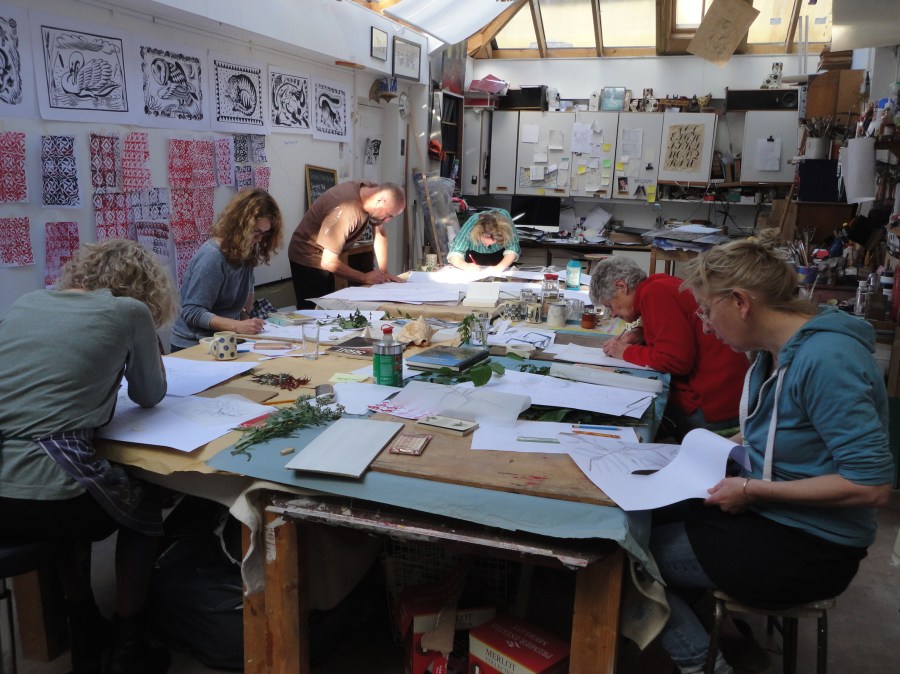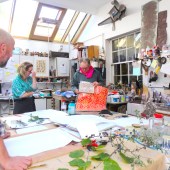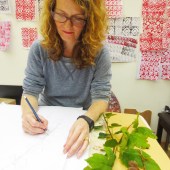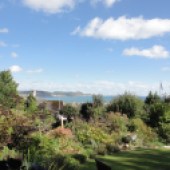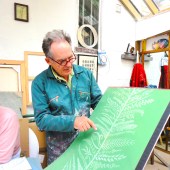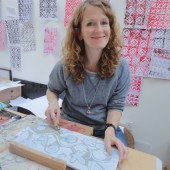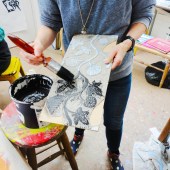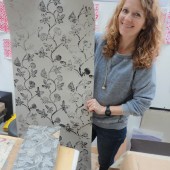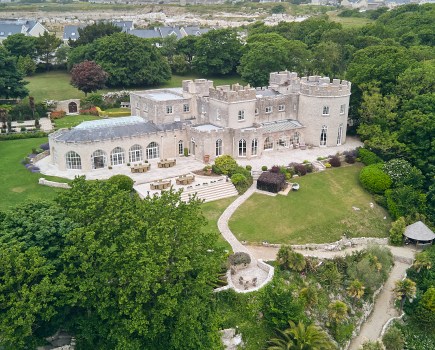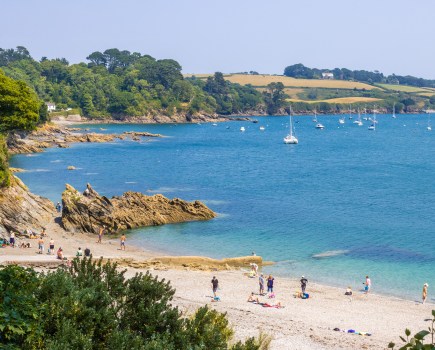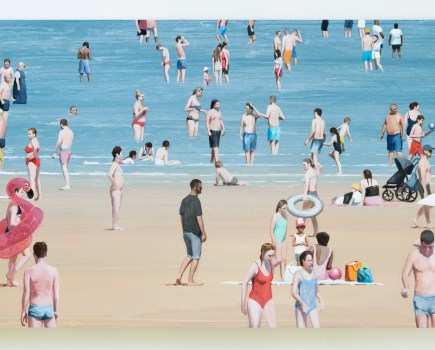Learn the craft of hand block-printing – and how to create coastal patterns for your home – on a wallpaper workshop in Lyme Regis. Words Alex Reece.
After years of minimalism being the dominant trend in interiors, it’s refreshing to see wallpaper having a moment, heralding a return of warmth, wit and personality to our living spaces. We are now so used to seeing digital- or machine-printed papers, however, we forget that before such technological advances in the nineteenth century, the most common method of production was hand block-printing.
When wallcoverings are handmade in this way, the human touch creates patterns that are more texturally interesting than their uniform, modern-day equivalents – and they can, of course, be tailored to suit your own unique specifications. It is also surprisingly easy to have a go yourself, although developing rhythmic repeats and zinging colour contrasts is where the real skill and artistry comes in.
This is the low-tech approach favoured by artist Hugh Dunford Wood (a one-time apprentice of painter and designer Peggy Angus), who began selling his own distinctive designs from his studio in Lyme Regis a decade ago. He runs weekend courses here on the Jurassic Coast, too, for aspiring makers – and promises that anyone who can draw a map has sufficient ability to create their own wallpaper. Now it’s time to find out…
DAY ONE
7PM ONE POTATO…
After knocking at the door to Hugh Dunford Wood’s studio – attached to the rear of his Georgian home, Little Place – it opens to reveal the artist himself, jazz playing on the stereo and four classmates already chatting, seated around two large craft tables. A cracking pace is set immediately when, with little introduction, Hugh announces, ‘We’re going to start with potatoes.’ He explains that this is the most basic form of printing – and an easy way of showing us one or two tricks. ‘You’ll be amazed by what you achieve this evening,’ he adds.
7.15PM KNIVES OUT
Hugh instructs us to cut our potatoes into square blocks (using a wood-carving knife set he’s given each of us) and make different marks on each half of the square. Using either red or black emulsion, we try out different print repeats. By making a half-rotation each time, for example, I produce a pattern that looks surprisingly like encaustic tiles. It is pleasing and compelling to watch this take shape. And, sure enough, when we wrap up at 9pm, there are proud smiles all round as we hang up our work – a bold display of zigzags, dots and diamonds.
DAY TWO
10AM TAKE A LEAF
It’s a rainy Saturday morning in Lyme Regis, but this does not dampen Hugh’s enthusiasm for taking us out into his sea-facing garden to collect the plant cuttings that will form the basis of our wallpaper designs. ‘There is no better teacher than nature,’ he confirms. Taking only as much as we need, we seek out leaves such as bamboo and ivy, which rise alternately out of the stem. These will work particularly well, as wallpaper patterns tend to lead the eye upwards.
10.30AM COMMIT TO PAPER
Back in the studio, with our foliage laid out in front of us, it’s the moment I’ve been dreading: drawing freehand. (I can doodle adequately on a telephone pad, but that’s about it.) After discounting fennel and holm oak, I focus my attention on ivy, owing to its clearly recognisable silhouette. When something vaguely OK arrives on the paper, I’m caught admiring my work – ‘Don’t be self-satisfied with that,’ chides Hugh, good-naturedly. The purpose of this exercise is observation and I’m encouraged to keep on looking.
11.40AM GUIDING PRINCIPLES
We break off from our work for a talk given by Hugh on wallpaper design and the technicalities of a half-drop repeat (which involves staggering your prints, like laying a brick wall). To illustrate further, he and wife Candida, an environmentalist also participating in the course, show us around their home to view Hugh’s wallcoverings in situ. There are iridescent silver plumes in the sitting room and swirling botanical patterns in the bedrooms (their home is also a B&B), all of which complement their collection of artworks – many of them by Hugh. We round off our tour with a shared lunch on the veranda.
2PM BOARD GAMES
Now we choose our lino boards – coursemate Mark, a youth worker and canoe instructor from Oxford, selects a large one for his drawings of spiky branches laden with sloes. I opt for something smaller-scale and start translating my sketches into a design to fit. I use ivy as the leading motif but, on Hugh’s advice, give the stem a snake-like curve for interest. I also add a coastal theme, with shells growing magically out of the foliage. The rhythm of creating a pattern is, apparently, something you have to get a feel for. ‘It’s like jazz,’ says Hugh.
3PM DRAWN AND QUARTERED
Hugh photocopies my finished design and cuts it into quarters so we can ensure it marries up every which way when repeat-printed. Then, using carbon paper, I trace and print the pattern onto my board (to my astonishment, it looks quite appealing) and I leave at 5pm with a huge sense of achievement.
DAY THREE
10AM GOUGE AWAY
This morning, we’re cutting away at our lino boards, following the outline of our designs using a V-shaped gouge. At least twice I make the schoolboy error of cutting towards myself and Hugh has to rush over with a plaster – but they are only superficial scratches and soon heal. While we are all busy hacking, Hugh gives a demonstration of how he works – he prints fast and can complete a roll in 45 minutes, which he drapes on racks hanging from the ceiling to dry.
11.30AM DEVIL IN THE DETAIL
Next, I’m picking out details – the grooves in the shells and the veins in the leaves – all with the same gouge. Chocolate biscuits and a radio version of Under Milk Wood keep us powering on. Once my design is fully etched out, Hugh uses tracing paper to check one final time that everything matches up, then we stop for another shared repast on the terrace.
2PM WE HAVE LIFT OFF
Candida is the first to start printing, and the energy in the room lifts as she peels back her lino to reveal a maple-leaf design. It’s beautiful. Hugh marks the back of my lino with an arrow (showing which way is up) and we’re ready to go – I paint my board, place it on the paper and press down hard all over it with a roller. The first print is a bit faint, which is often the case with a dry board, but then the second comes out strong and, well, very wallpaper-like. ‘I think it’s a successful design,’ says Hugh. ‘Your eye is drawn equally to the leaves and the shells and it is not overwhelmed by the architecture of the stem.’ I’m thrilled.
3PM KEEP CRAFTING
More ‘big reveals’ follow: Glastonbury-based stone conservator Lucy’s elegant bamboo pattern is greeted by applause. Then we start experimenting with colour. I slather on a pale-blue emulsion and print on to red-painted lining paper – the result is something I’d be delighted to have in my home. The fact I don’t draw makes it even more precious to me. Hugh urges us not to stop there, as we make off with armfuls of paper: ‘Get out there and fill the world with pattern.’
Little Place, Silver Street, Lyme Regis, Dorset handmadewallpaper.co.uk The next Wallpaper Design Weekend Workshop is on 12-14 June and costs £250 per person.
Originally published in the April 2015 issue of Coast.
NEED TO KNOW
HOW TO GET STARTED
Buy lino and cutting tools from handprinted.net. To make printing blocks, Hugh sticks lino on to hardboard (try builders’ merchants) with Evo-Stik. All his paints are Dulux matt emulsion and applied with standard paintbrushes. For the lining paper (also from builders’ merchants), use a grade of 1,200. Printing can be done on a dining table as wide as your roll.
WHAT IT COSTS
Very little – a lino sheet starts at about £1.50 online and a wood-carving knife set costs around £10. If you use paints and brushes that you have to hand, lining paper also costs only a couple of pounds a roll. A roller might set you back £5-£25.
GETTING THERE
The nearest station to Lyme Regis is Axminster; there are direct services from London Waterloo. Catch the X31 bus to Lyme Regis from the stop outside the station – the journey takes 25 minutes.
WHERE TO STAY
Dorset House dorsethouselyme.com is a luxurious B&B just a short stroll from Hugh’s studio. Owners Lyn and Jason Martin have recently renovated the Grade II-listed, Regency building and rooms now have a smart blend of modern and vintage furnishings. Double B&B from £100.
ASK THE PRO
Artist Hugh Dunford Wood had a hand-painted silk fashion business in the 1980s and 1990s, selling worldwide. Here he reveals how he began making wallpaper:
‘I trained as a fine artist but after a chance encounter with Peggy Angus I started printing wallpaper for her. I then made it for myself, and it was only really when we moved down here that people started looking round the house and saying, ‘Where on earth did you get this wallpaper?’ I’ve been making it commercially for about 10 years. I’ve had people coming here from Hong Kong to learn wallpaper design. Too many people think the computerised world is it, when man has forever been a handworker. It is important to me to pass on the skill, so more people can pass it on to others.’

